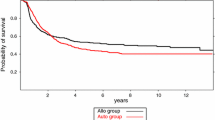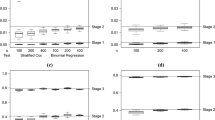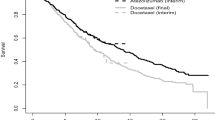Abstract
In clinical trials survival endpoints are usually compared using the log-rank test. Sequential methods for the log-rank test and the Cox proportional hazards model are largely reported in the statistical literature. When the proportional hazards assumption is violated the hazard ratio is ill-defined and the power of the log-rank test depends on the distribution of the censoring times. The average hazard ratio was proposed as an alternative effect measure, which has a meaningful interpretation in the case of non-proportional hazards, and is equal to the hazard ratio, if the hazards are indeed proportional. In the present work we prove that the average hazard ratio based sequential test statistics are asymptotically multivariate normal with the independent increments property. This allows for the calculation of group-sequential boundaries using standard methods and existing software. The finite sample characteristics of the new method are examined in a simulation study in a proportional and a non-proportional hazards setting.
Similar content being viewed by others
References
Andersen PK (1993) Statistical models based on counting processes. Springer, New York
Bauer P, Posch M (2004) Letter to the editor on “Modification of the sample size and the schedule of interim analyses in survival trials based on data inspections”. Stat Med 23(8):1333–1334. doi:10.1002/sim.1759
Billingsley P (2009) Convergence of probability measures. Wiley, New York
Brückner M (2015) AHR: estimation and testing of average hazard ratios. R package version 1.3. http://cran.r-project.org/package=AHR. Accessed 31 Oct 2015
Jennison C, Turnbull BW (1999) Group sequential methods with applications to clinical trials. CRC Press, Boca Raton
Kalbfleisch JD, Prentice RL (1981) Estimation of the average hazard ratio. Biometrika 68(1):105–112
Li Z (1999) A group sequential test for survival trials: an alternative to rank-based procedures. Biometrics 55(1):277–283
Malani HM (1995) A modification of the redistribution to the right algorithm using disease markers. Biometrika 82(3):515–526
McGuire WP, Hoskins WJ, Brady MF, Kucera PR, Partridge EE, Look KY, Clarke-Pearson DL, Davidson M (1996) Cyclophosphamide and cisplatin compared with paclitaxel and cisplatin in patients with stage III and stage IV ovarian cancer. N Engl J Med 334(1):1–6
Mok TS, Wu YL, Thongprasert S, Yang CH, Chu DT, Saijo N, Sunpaweravong P, Han B, Margono B, Ichinose Y, Nishiwaki Y, Ohe Y, Yang JJ, Chewaskulyong B, Jiang H, Duffield EL, Watkins CL, Armour AA, Fukuoka M (2009) Gefitinib or carboplatin paclitaxel in pulmonary adenocarcinoma. N Engl J Med 361(10):947–957
Murray S, Tsiatis AA (1996) Nonparametric survival estimation using prognostic longitudinal covariates. Biometrics 52(1):137–151
Murray S, Tsiatis AA (1999) Sequential methods for comparing years of life saved in the two-sample censored data problem. Biometrics 55(4):1085–1092
Murray S, Tsiatis AA (2001) Using auxiliary time-dependent covariates to recover information in nonparametric testing with censored data. Lifetime Data Anal 7(2):125–141
Oza AM, Cook AD, Pfisterer J, Embleton A, Ledermann JA, Pujade-Lauraine E, Kristensen G, Carey MS, Beale P, Cervantes A, Park-Simon TW, Rustin G, Joly F, Mirza MR, Plante M, Quinn M, Poveda A, Jayson GC, Stark D, Swart AM, Farrelly L, Kaplan R, Parmar MKB, Perren TJ (2015) Standard chemotherapy with or without bevacizumab for women with newly diagnosed ovarian cancer (ICON7): overall survival results of a phase 3 randomised trial. Lancet Oncol 16(8):928–936
Pepe MS, Fleming TR (1989) Weighted Kaplan–Meier statistics: a class of distance tests for censored survival data. Biometrics 45(2):497
Putter H, Sasako M, Hartgrink HH, van de Velde CJH, van Houwelingen JC (2005) Long-term survival with non-proportional hazards: results from the Dutch Gastric Cancer Trial. Stat Med 24(18):2807–2821
R Core Team (2015) R: a language and environment for statistical computing, version 3.2.2 (released 14.08.2015). R Foundation for Statistical Computing, Vienna. http://www.R-project.org/
Sellke T, Siegmund D (1983) Sequential analysis of the proportional hazards model. Biometrika 70(2):315–326
Shen Y, Fleming TR (1997a) Large sample properties of some survival estimators in heterogeneous samples. J Stat Plan Inference 60(1):123–138
Shen Y, Fleming TR (1997b) Weighted mean survival test statistics: a class of distance tests for censored survival data. J R Stat Soc B 59(1):269–280
Struthers CA, Kalbfleisch JD (1986) Misspecified proportional hazard models. Biometrika 73(2):363–369
Tsiatis AA, Rosner GL, Tritchler DL (1985) Group sequential tests with censored survival data adjusting for covariates. Biometrika 72(2):365–373
Wassmer G (2006) Planning and analyzing adaptive group sequential survival trials. Biom J 48(4):714–729
Acknowledgments
We are grateful to the Associate Editor and a Reviewer for their comments, which have substantially improved the paper. This work was supported by the Program “Mathematics for Innovations in Industry and Services” of the German Federal Ministry of Education and Research (BMBF) under Grant 05M13VHC.
Author information
Authors and Affiliations
Corresponding author
Appendix: Proofs
Appendix: Proofs
Proof (Proof of Theorem 1)
Following the arguments of Kalbfleisch and Prentice (1981) for the Kaplan–Meier estimator, we have in the general case
and
Define the linear map \(\phi {\text {:}}\,(D[0,\,L])^{2K} \rightarrow \mathbb {R}^{2K}\) by
From Assumptions 1–4 it follows that \(n^{1/2}\{\hat{S}_i(t_l,\,\cdot ) - S_i(\cdot )\}\) converges weakly to a mean zero Gaussian process \(U_i(t_l,\, \cdot )\) with covariance function \(\nu _i^{-1}\rho _i(t_l,\,\cdot ,\,\cdot )\) as \(n\rightarrow \infty \) for each \(l=1,\ldots ,K.\) The covariance of any two of these processes is
because of the independence of the samples and Assumption 3. Define the vectors
It then follows from Eqs. (8) and (9) and the continuous mapping theorem, that as \(n \rightarrow \infty \)
Since \(\phi \) is linear, the vector \(\mathbf {\phi (\mathbf {U})}\) has a multivariate normal distribution with mean zero and covariance matrix
where
The covariance matrix \(\mathbf {\Sigma _\theta }\) can be derived using Eq. (10) and Fubini’s theorem. The claimed asymptotic normality now follows by noting that
Consistency of the variance estimator follows from the uniform consistency of \(\hat{S}_i,\) by Assumption 2, and \(\hat{\rho }_i,\) by Assumption 4 (\(i=0,\,1\)).
Rights and permissions
About this article
Cite this article
Brückner, M., Brannath, W. Sequential tests for non-proportional hazards data. Lifetime Data Anal 23, 339–352 (2017). https://doi.org/10.1007/s10985-016-9360-5
Received:
Accepted:
Published:
Issue Date:
DOI: https://doi.org/10.1007/s10985-016-9360-5




